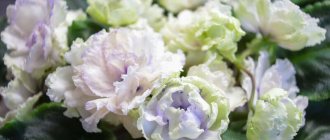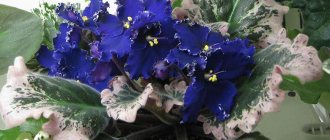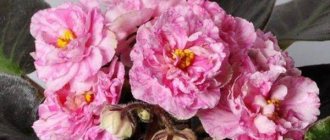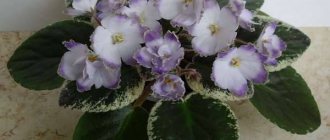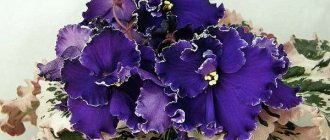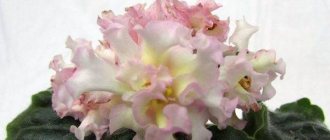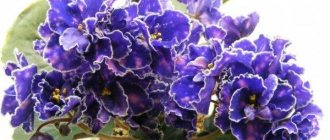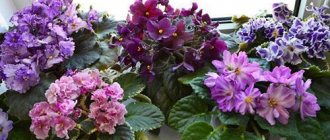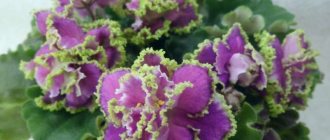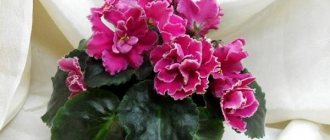- Description Reviews —>
Jura S., Semi-double and double large red-crimson flowers with a burgundy fantasy border and a thin white edging.
Medium green foliage with red undersides, yellow-olive crown variegation. Found a mistake? Report it: 1) Select the error with the mouse 2) Press CTRL+Enter. Read more.
Violet JuS-Adelina, Svetlana Dzhura (Pikalenko)
There is no author's description yet, a collector's description: semi-double and double large red-crimson flowers with a burgundy fantasy border and a thin white edging. Medium green foliage with red undersides, yellow-olive crown variegation.
Properties
Name
- Original: JuS-Adelina
- Transcription:
- Translation:
Registration
- Selection: S. Dzhura (Pikalenko)
- Year: 2013
Socket
- Socket type: standard
Flower
- Flower size, up to: 6 cm
- Flower shape: star
- Terry size: semi-double, terry
- Main color: red-raspberry
- Color type: plain
- Border: double
- Other Features
Foliage
- foliage color: medium green
- foliage type: simple
- foliage shape: heart-shaped; quilted
- reverse side of sheet: red
- leaf edge: jagged edge
- variegation: crown (Champion)
Peculiarities
Large, up to 6.0, 6.5 cm, bright red-crimson flowers are located on strong, not very tall peduncles. The flower is decorated with a double border - a burgundy fantasy border and a thin white one. The flowers are semi-double and double, the petals have a wavy edge. Flowering is very long and the flowers retain their bright color, only becoming slightly lighter towards the end of flowering.
The rosette is even, flat, not very large with medium green foliage and crown olive-yellow variegation. The variegated foliage is not stable; it is better manifested in cool conditions.
It grows well both on top watering and on wick. The variety is not demanding in care and maintenance. The first flowers appear 6-7 months after the babies are planted.
Violet JuS-Adelina, photo by T. Lysikova:
remnants of crown variegation with increasing temperature:
Violet is one of the most popular indoor plants.
Breeders were able to produce large quantities of this flower. Among the variety of species, there are double and semi-double varieties.
The shades of the petals can be very different, so every gardener has ample opportunities to create an interesting and original flower arrangement right at home.
Features of flowering, growth and reproduction
The variety blooms with medium flowers in the shape of double stars of crimson color . Flowering is abundant, at least twice a year.
This variety blooms at least twice a year.
Development at home
The plant is adapted both to growing conditions in a house (apartment), and in greenhouses and flower beds , in open ground. It easily and quickly adapts to home conditions, as a result of which it actively develops and blooms profusely.
How long does it take to grow an adult plant?
It is possible to grow an adult JuS-Adelina flower in just one year .
How are varietal characteristics transmitted?
Varietal characteristics are transmitted only when the plant is propagated by leaves.
Features of flowering in hot and cool conditions
If we talk about what climatic conditions are more conducive to the flowering of Saintpaulia, it would be logical to assume that heat is more conducive to flowering, since the natural climate for violets is deserts and tropics.
In fact, average temperatures are considered , when the flower receives a sufficient amount of cool air.
What do flower stalks look like?
The flower stalks are triangular in shape and pale pink.
Is it possible to achieve cap flowering?
Provided proper care and compliance with all the rules for maintaining the flower, it will make its owners happy with frequent and high-quality flowering.
Bud lifespan
The variety blooms for a month.
Flowering lasts at least one month, after which it is replaced by a period of dormancy.
The role of breeders in breeding varieties
And although many may think that selection work is complicated, it can be done by an ordinary person who has minimal knowledge in the field of biology.
Thanks to breeders, it has become possible to obtain numerous varieties that differ in color, type of flowers, and leaves. In addition, breeders obtain varieties that are grown under certain conditions . Thus, each gardener can choose the best option for himself, taking into account experience and personal preferences.
Description of species by breeder with photo
Check out the photo descriptions of the varieties: Apple Orchard, Tsar Peas, Rustle of Waves and Ness Orange Pekoe
D.Ness - Ness Orange Pekoe
Violets are large, double or semi-double. Their color is coral. During flowering, an effective bouquet is created against the background of an even display variegated rosette. The shape of the violet flower is clearly defined. 3-5 flowers are formed on one peduncle. taking into account the conditions of maintenance, the flowers can be bright coral or coral-fawn.
The peculiarity of the variety is that on the same rosette the brightness of flowering can be different. Characterized by long and frequent flowering. The rosette is self-forming. The variegation is pink-cream and looks very bright on young flowers. At elevated temperatures, variegation may disappear.
But as soon as the rosette is placed in a cooler place, brightly colored variegated leaves again form from the center of the rosette. The flower responds positively to natural light, although it grows and blooms well under artificial light. Propagated by cuttings, produces many children.
A. Kuznetsov – SK-Apple Garden
Semi-double white flowers. Its foliage is light green and has pointed edges. The rosette is beautiful, 9-14 cm. The flowers are white and semi-double. Only at the edges of the petals is there pink color. The size of the flowers is 2.5-3 cm. During flowering, a lush bouquet is formed on the peduncles. Peduncles are short, strong and stable.
The pink and white cap almost completely covers the rosette. The petals are characterized by increased density. Flowering duration is 1.5-2 months. Instead of old faded flowers, new ones come. To prolong flowering, you need to place the pot in a cool room. If the temperature is exceeded, the tips of the upper petals turn crimson.
The variety reproduces quickly and blooms early. Keep on wick watering, avoid overfeeding. If the leaves of the rosette darken, the petals will begin to float with a crimson border.
Tatiana Valkova
WAT Snow White
Large flowers that look like stars. The main color is pink, and along the corrugated edge there is a bright crimson edging. The rosette is neat and consists of green leaves. They are long with wavy edges. Flowering lasts 3 months. At this time, the flowers are lush and bright.
In terms of care, the plant is not picky; regular watering and natural light remain important for it .
King Pea
The leaves are large, smooth, with a cream edging. The rosette is neat, the leaves are slightly inclined downwards. The petals are dark blue, and bright crimson peas are scattered across their surface. The petals have a beautiful white and slightly wavy edge. Flower size is 6-7 cm.
Flowering is abundant and long lasting. The variety prefers warmth. If you keep it cold, the flowers will not be as bright.
G. Lazarenko – Rustle of waves
The flowers are large and simple. They are semi-double and light blue in color. The edges of the petals are wavy and have a white corrugated edge. The leaves are bright green with wavy edges. They are large, corrugated and rigid, but quite fragile.
You need to be extremely careful with them, as one wrong move and the leaves will quickly break off. The petioles of the leaves are long, the rosette is slightly loose. Flowering occurs already in the first year after planting. The peduncles are long, but they cannot withstand the weight of the flowers. 4-6 buds are formed on peduncles.
In terms of cultivation, the variety is not capricious. Overwatering has a detrimental effect on plant development. The flower does not require bright lighting and does not tend to lift its leaves upward.
K. Stork
Emergence
A single or semi-double red pansy with a white furrowed edge. The flower consists of 5 petals. The color is dark pink, and the edges of the petals are wavy and white. The leaves are wavy along the edges. The underside of the leaves is red, and the outside is dark green, covered with light fluff.
Quilting Bee
This variety allows you to grow double, corrugated white flowers. There is a slight lavender shadow on the petals. The flower size is 3 cm. The leaves are quilted, bright green and slightly wavy. The rosette is loose, the leaves are directed in different directions. The flowers are white-lilac, lush and voluminous.
Their size is 3 cm. The petals are delicate with a carved edge. Every flowering is a surprise for the gardener. The fact is that there are two lines: one is light and the other is darker. The main color is lilac, but it can be of varying degrees of saturation.
The bloom looks like a foamy lace bouquet. The opening of the buds occurs slowly. In terms of cultivation, the variety is undemanding. It does not grow very quickly, but needs regular and abundant watering.
B. Kostsevyat – Valentina Tereshkova
This plant forms a rosette of green leaves. Its size is 16 cm, and the leaves are 4 cm. The flowers are small, size 5 cm. The petals are white-blue in color, the edges are wavy. Flowering is lush and long lasting. With age, the size of the rosette increases, and the flowering becomes lush and beautiful.
D. Denisenko
DN - Young French girl
Large, bright purple pansies with a wide, light and heavily ruffled border. Variegated rosette. The leaves are dark green, wavy along the edges. 4-5 flowers are formed on one peduncle. Flowering is lush and long lasting.
At this time, the flower stalks cannot withstand the weight of the buds and bend slightly. Keep the flower in a cool place, in natural light and with regular watering.
DN-Rozheva Konvaliya
The flower looks like a bell. The main shade of the petals is pure pink, and there is a purple edge around the edges. The petals are corrugated and dense. Leaves are dark green.
They are wide and have a pointed end. Grows well in natural light and requires regular watering. Flowering is abundant and frequent.
I. Nizkous – Wedding bells
The leaves are small but wide. They are dark green in color, with pronounced veins. The flowers are small in size - 3 cm. The main color is soft pink, and at the edges there is a blurry bright pink color. The petals are delicate and corrugated at the edges.
N. Kozak – A feeling of celebration
The flowers are bright lilac. They are lush and their edges are corrugated. Features of the variety are the interesting color of the leaves. Their main color is dark green, with light blurry spots scattered throughout it. The variety is distinguished by strong peduncles.
Flowering is long and lush. When all the buds bloom, a colorful bouquet is formed against a background of light green leaves. In terms of care, the plant is not demanding:
- daylight;
- regular watering;
- maintaining temperature conditions.
O. Aksenkina – Deo Marzipan
The flowers are beige-pink. They are shaped like marzipan roses. The leaves are dark green, pointed at the tip. They bend over the pot, looking in different directions. The plant feels great under a lamp, on a windowsill and in the shade. The size of the flowers is 3-4 cm. There are 4-5 of them on the peduncle.
Flowering is lush and abundant. The flowers last a long time. Since the flower stalks are weak, the flowers fall on the foliage .
O. Kosobkova – Watch
This variety is characterized by large double and semi-double flowers. They are white with cherry highlights and a thin wavy green border around the edges. Their size is 3-4 cm. The rosette is smooth and medium green. The leaves are wavy and wide. Flowering lasts a long time, and you can see it after transplantation in 5-7 months.
R. Sorano
Sassy Sister
The leaves are light green, wavy at the edges. The diameter of an adult rosette is 10-17 cm. The flower is densely double, dark pink in color. There is fringe along the edges. The buds are presented in bronze color. Up to 20 flowers are formed on one peduncle.
This variety of violets has 3 varieties:
- Dark pink flowers.
- White with a slight pink tint.
- Soft pink with a wide white edge and jagged edges of the petals.
Flowering is abundant and long lasting. An adult rosette forms 5-7 flowers on peduncles. All flower stalks are directed in different directions.
Already 9-12 months after planting, the plant blooms. Grows well on top and wick watering.
Leding Lady
The foliage is medium green, quilted and serrated. The rosette of the flower is large and easily formed, but the petioles tend to elongate. The flowers are pink, pointed. They have lace edges and double edging: a ruffled thin white edge and a lilac frame. During the first flowering, the flowers are not double.
Flower size is 5-6 cm. Flowering duration is 2 months. And although the peduncles are long, they cannot withstand the weight of the flowers and droop. Violets are grown in natural light. If it is strong, then burnt spots will form on the leaves.
Svetlana Dzhura (Pikalenko) – Juice Adelina
The flowers are large, semi-double. The main color of the petals is pink, and along the corrugated edges there is a lilac edging. The leaves are simple quilted, small in size. Their color is interesting - near the veins it is dark green, and from there it turns into a light shade.
Ian Zubo
River Severka
Leaves are round, golden crown variegated. But with the beginning of flowering it disappears. Flowering is not too abundant, but constant. Flower size is 3-4 cm. Peduncles are long and thin. With the onset of the first flowering they fall apart. Clusters of 3-6 flowers are formed on one peduncle.
The variety is prolific, blooms well on the shelf 7 months after planting. The rosette is self-forming. The plant prefers natural light. Watering should be moderate. But sudden changes in temperature are unacceptable.
Elizabeth
The leaves are two-colored: dark green and white-cream. They have a heart-shaped shape, a glossy surface and wavy edges. The flowers are double and light pink. The edging is thin and pencil-like. The flowers are fluffy and delicate, but small in size. During flowering, a lush bouquet is formed.
The flower stalks are strong and many buds are formed on them at once. The variety requires natural light. Otherwise, long petioles grow. The plant reacts negatively to moisture and is sensitive to overwatering.
Ueki Masahiro – Yukako
The flowers are wavy blue, shaped like stars. Each petal has a bright green stripe. The size of the flowers is 2-3 cm. As they grow, the color intensity decreases.
The foliage is quilted, medium green and wavy. The leaves are large and curl downwards. Flowering is frequent and abundant. Flowers bloom even in hot weather. They feel great and don't wilt.
The variety requires less light than other varieties of violets. Avoid drying out the soil and direct sunlight. Violet is a herbaceous plant that is so popular among gardeners.
Care techniques in the home microclimate
In the microclimate of indoor collections, the violet is distinguished by its very unpretentious behavior - the plant responds to the regular and careful implementation of agrotechnical practices typical for the genus by harmonious development and flowering:
- the plant likes to grow on windows facing west or east , where a suitable balance of volume and light intensity is maintained: windows in the north direction should be equipped with an additional illumination system with diffuse spectrum rays;
- on southern windowsills, violets will need a light curtain in the summer heat.
- watering - dosed. Strict control over the condition of the upper part of the substrate is required - at each stage of watering, the soil in it must have time to dry out;
- to apply mineral fertilizing too often - the violet itself can indicate the need for this procedure with its appearance;
- proper lighting makes it possible for the harmonious development of violets - the tropical beauty needs diffused rays of daylight when exposed to them for a sufficiently long time;
- the temperature gradient should be maintained at +20 + 24°C. Do not expose the violet to sudden changes in temperature and drafts;
- when creating comfort, it is necessary to provide the violet with rich nutrition through fresh, aerated and permeable soil with sufficiently reliable drainage;
- At the time of transplantation, it is better to use the transshipment technique - it is less painful for the violet.
